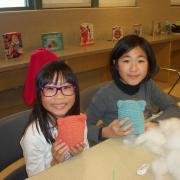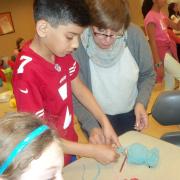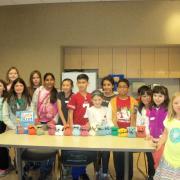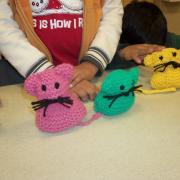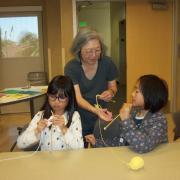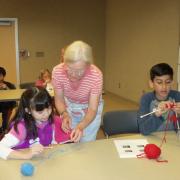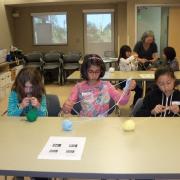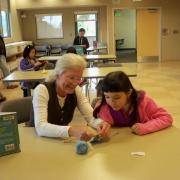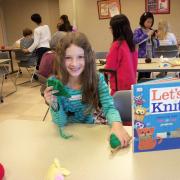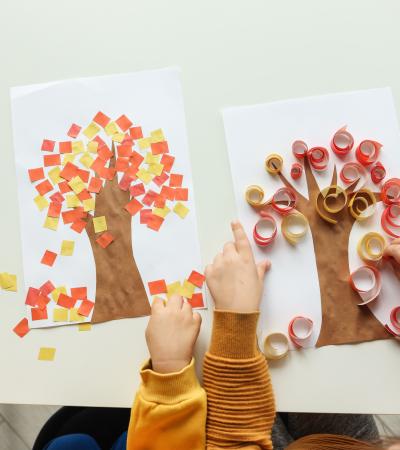Children (ages 8 to 11) signed up for a series of beginning knitting workshops taught by older adult volunteers. Over three sessions, children learned basic knitting techniques that led to a completed project. Each session was led by five adult volunteers and was limited to 20 children.
Our first series — Knit a Kitty — was so successful that we have since offered three more. The workshops filled up quickly, and most children returned to attend subsequent classes.
Advanced Planning
Since we had never done a knitting program before, we pre-planned this program for six weeks. Our lead knitting teacher, Ursula Matheson, was instrumental in getting funding for the program. She presented a budget and program goals to our Friends group. Once approved, she purchased the materials.
One hurdle we had to overcome was that Matheson had never taught knitting to children before. However, this turned out to be a non-issue because she is an amazing teacher. Another unexpected challenge Matheson faced was trying to organize several other volunteers to help. They had to arrange their schedules to be available for the class. Also, since there are different knitting techniques, together they had to plan an age-appropriate project and strategize how to teach the class.
For each workshop series, we hosted one session each week for three weeks. Our classes meet for 90 minutes, once a week, giving the students sufficient time to complete a small project. To complete their project, students were required to attend all three sessions in a series. (View knitting patterns under Attachments at right.)
Below are some examples of workshop series we've hosted by timeframe and project:
- Jan. 30 to Feb. 13, 2017: Knit a Kitty
- March 13 to April 3: Knit a Bunny
- April 24 to May 8: Knit a Mother’s Day Present
- May 15 to June 5: Knit a Mouse
Marketing
For the first session, I advertised using in-house marketing, the internet and posted fliers throughout the library. I also promoted it on the Los Angeles Public Library website.
About two weeks before the program, I sent emails to parents/guardians of school-aged children. Children had to sign up in advance and commit to attending all three sessions. I also sent reminder emails and kept track of who had registered.
The marketing was very successful, and we got the perfect number of students for the class. Almost everyone (about 16 students) completed the entire workshop series and returned for future series. We also added a few new students to each series.
Budgeting
The only cost for this program was the materials. The Friends of the Palms-Rancho Park Library bought 25 pairs of knitting needles and one set of darning needles, which totaled $106.
The other materials, including more needles, yarn, stuffing, scissors and volunteer time, were donated.
Day-of-event Activity
The set-up can be done quite efficiently with only one staff member. The tables and chairs are arranged classroom-style, facing the front. All materials are laid out for the children so they can easily get their work and start on the projects.
I put out nametags so we could get to know the children’s names. They used the nametags to label their work for the next time.
Program Execution
Twenty-one children registered for the first program, which is the number we targeted. We intended to keep the program small so the volunteers could spend quality time teaching each student and working in small groups. The volunteers helped students individually with their mistakes and answered questions. The sessions went very smoothly, and the children enjoyed meeting their friends (or making new ones) and chatting while they knitted.
In the first class, our volunteers faced a challenge. There was a big learning curve in learning to knit, and it was difficult for them to teach 21 non-experienced knitters at once. Another unexpected challenge was that some of the children picked up knitting faster than others. To prevent some children from falling behind, the volunteers took home the children’s unfinished work to help them complete their projects.
We not only achieved our goals, but we exceeded them. We got amazing, positive feedback, and the children and their parents loved the program. Many students became very excited about knitting. They checked out the display books, bought their own materials and began knitting projects on their own time. (View a related reading list under Attachments at right.)
For me, the way to evaluate the success of a program is by how many people return. The most amazing thing about this program is that almost everyone who started the first workshop series continued on to subsequent series. The program is so successful that I no longer advertise it to the general public, but just to those on our knitting email list.
Another mark of success: we initially only planned one series, but the kids all wanted to continue, so we ended up adding on additional series with new projects. Not only are we teaching beginning knitting in the library, but knitting became very popular in our community. Two fifth graders from the class started a knitting club at their school. Also, some of the girls in the class want to do a charity knitting project with their Girl Scout troop.
Advice
Librarians should be open to new programming ideas. With no prior experience working with kids, Matheson created a program that surprised us all.
We had no idea that it would be this popular and spread to the school, Girl Scouts and home activities. Some of our students make projects outside of this class and share their work with us. I love that this class is inspiring creativity and good-will projects.
Be prepared for the first class. It is definitely the hardest because there is a big learning curve for first-time students and teachers. After the first class, things get a lot easier and more fun. Also, cushion enough time in the class for most of the students to finish their projects on their own without the instructors taking home the unfinished projects. For our classes, we do not let the students take home their unfinished work because we might not get the knitting needles back.
Finally, each student will work at their own pace. Some will learn faster and be quicker knitters than others, so build in extra projects if they finish early.
Supporting Materials
- Feedback (Coming Soon!)
- Programming Librarian Facebook Group

